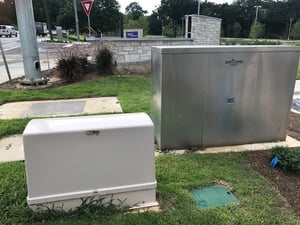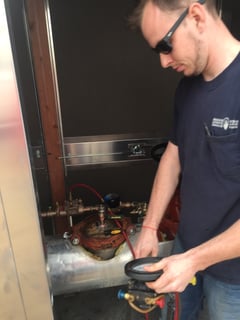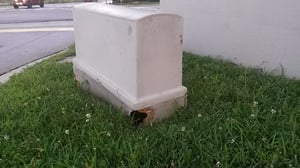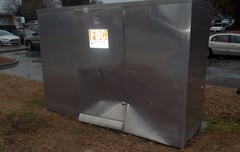
As with most things, once an idea is accepted, established and entrenched, that status quo is difficult to change. That’s the case with fiberglass enclosures. Throughout the United States, fiberglass enclosures are commonly installed for backflow assemblies.
There's another powerful factor that keeps the status quo locked in place: cost. Fiberglass is widely thought of as cheap to manufacture, assemble and sell, when the reality is that aluminum enclosures are available at comparable cost and provide both superior benefits and long-term value. Here are a few factors for those committed to the status quo to consider regarding the long term costs of fiberglass enclosures versus aluminum enclosures.
Sunlight
Fiberglass -The sun wreaks havoc on just about anything it reaches, from sensitive skin to that Independence Day cookout potato salad that didn't get put back in the fridge. In the case of fiberglass, prolonged exposure to direct sunlight can result in fiber bloom. If the enclosure doesn't have a UV inhibitor, the sun's rays will eventually break down and weaken the fiberglass.
If you are considering a fiberglass enclosure or shelter, be sure to ask the manufacturer for details concerning UV inhibitor availability. You don't want to be worrying about whether the enclosure will perform as intended in 20 years.
Aluminum - Sunlight will not impact aluminum's structural properties. 30, 40, even 50 years from now, with proper care and attention, your Safe-T-Cover aluminum enclosure should be in excellent condition and providing the same quality protection for the interior equipment as it did the day it was installed.
 Access
Access
Fiberglass - There are two main designs for fiberglass enclosures. One is the lift-top style where the enclosure either looks like a clamshell, or is small enough that the entire box is on a hinge which can be lifted to reveal the equipment underneath. This would provide sufficient access to equipment for maintenance if the enclosure is small. For larger equipment, including flange-sized and larger backflow preventers, you'll see fiberglass enclosures with hinged doors and roofs. Once again, this design would work well enough for routine maintenance, but what if the equipment needs to be lifted out and replaced? From what we've seen on the market, fiberglass enclosures do not typically have a removable roof or any easy way to readily replace failed or damaged equipment.
Aluminum - Not all aluminum manufacturers follow the same practice, but Safe-T-Cover employs modular design. This means that you can choose to add removable or hinged access panels and doors just about anywhere on the enclosure. Maintenance personnel can enjoy easy access to equipment and ample room to maneuver within larger enclosures.
Safe-T-Cover also ensures that each enclosure we make has an easily detachable roof so that the equipment can be lifted out from the enclosure. If you are looking for a durable pump cover solution, this is especially important to keep in mind.
Accidents

Fiberglass - First of all, the weed whacker is the bane of every fiberglass backflow cover. Here’s a picture of what happens when the weed eater comes in contact over time with the backflow cover.
This installation is at a drug store in western North Carolina. This enclosure will not provide adequate freeze protection the building owner paid for. Unfortunately, we've seen this type of damage again and again over the years. There is no good reason for it to continue.
Additionally, fiberglass is prone to shatter and fracture with even moderate impact. If a delivery truck backs into your cover, or a tree limb falls on it, you will likely need to replace the whole thing.
Aluminum - All things being equal, if a car or tree damages an aluminum enclosure, you may still need to replace the entire enclosure. However, with Safe-T-Cover's modular approach and panel-forward design, you may be able to just repair or replace panels. Aluminum will crumple and bend rather than shatter, and with resilient redwood bracing underneath, our enclosures stand a greater chance of withstanding impact.
Repairs

Fiberglass - Some fiberglass shelters are shipped fully assembled and put in place with a crane. This alone indicates any repairs may not be as fast as one thinks.
It's also more likely that repairs to fiberglass are more costly: an entire shelter or enclosure needs to be replaced even if only part of it is damaged. Field repair may be the quickest solution to the problem, however most fiberglass repairs must be done when temperatures are at least 65 degrees Fahrenheit and moisture will cause repairs to fail.
In the right conditions, fiberglass can be repaired with a patch, acetone, sandpaper and a Dremel tool. Then you'll need resin, hardener and to apply a new layer of gel-coat as well.
Aluminum - Because of our modular design, and as mentioned above, Safe-T-Cover's aluminum enclosures can replace a single damaged panel or selected panels. Our standard enclosure lines are manufactured using a few panel sizes, meaning we typically have each type in stock ready to be shipped. This is a quick and inexpensive repair that can done at any time during the year, meaning your equipment is fully protected again in a short period of time.
If the aluminum shelter or enclosure is a popular standard model, the manufacturer might be able to ship a complete enclosure the next day if needed. Safe-T-Cover is proud to have industry-leading turnaround times for our ship-ready and custom enclosure solutions.
Cost
For small diameter sizes only, fiberglass enclosures will typically cost a bit less. That is, if you only consider the up front costs rather than the costs associated with the life of the equipment. Repairing fiberglass enclosures is more difficult and expensive than ordering a new aluminum panel.
Additionally, for flange-sized installations, an aluminum backflow enclosure costs the same and sometimes even less than a fiberglass enclosure. As the purchaser, you want to buy the right one. After all, the enclosure is probably covering a critical and expensive piece of equipment. You want it to deliver on its intended purpose and provide you peace of mind.
Don't settle for the status quo. Come talk to our team at Safe-T-Cover and see why our aluminum enclosures are the best solutions under the sun.




